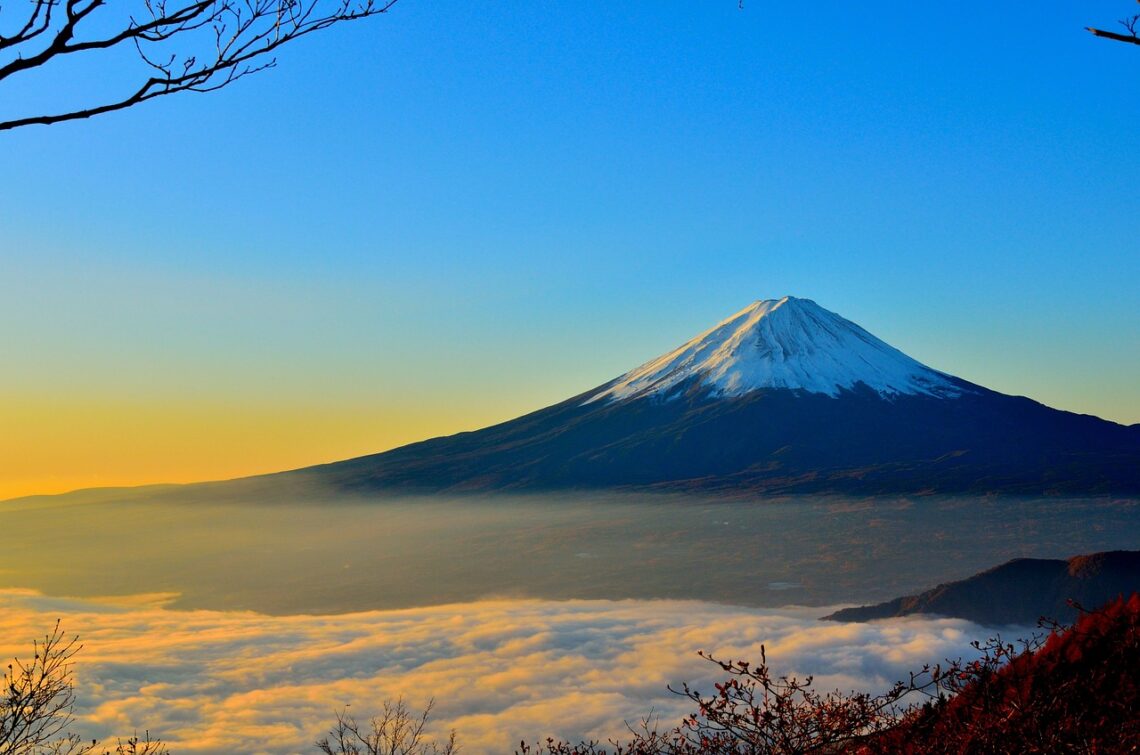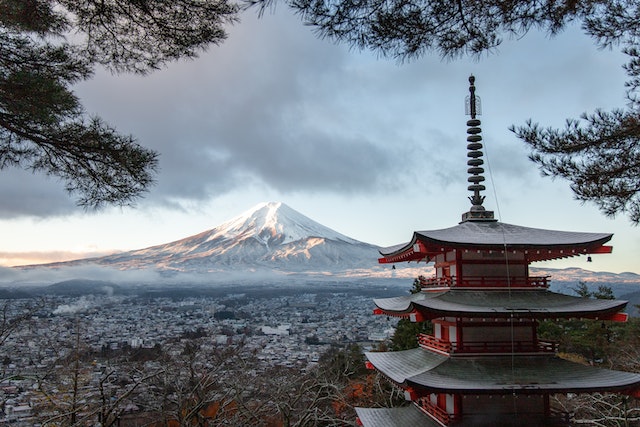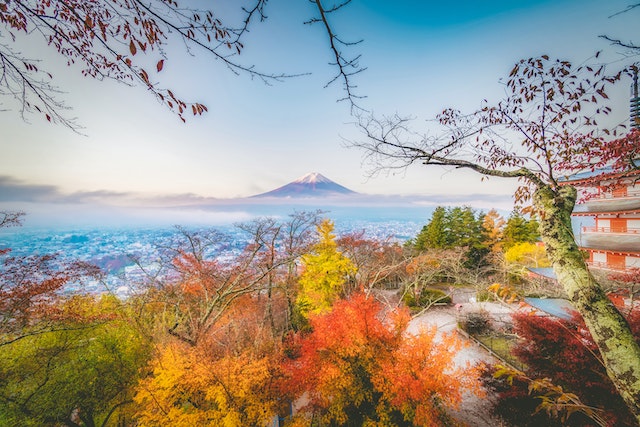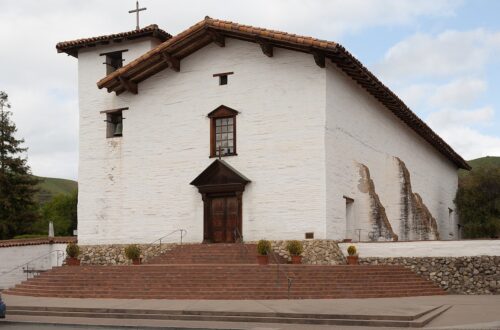
The Best Facts About Mount Fuji – Japan’s Iconic Peak
Interesting Facts About Mount Fuji
Mount Fuji, also known as Mt. Fuji, is an awe-inspiring active volcano and the highest mountain in Japan, standing tall at 3,776 meters (12,389 feet). We will Discover more interesting facts about Mount Fuji below.
Revered as a sacred site and a symbol of Japanese culture, this majestic mountain has captivated the hearts of people from around the world.
In this article, we will delve into the intriguing facts surrounding Mount Fuji, uncovering its rich history, breathtaking views, and remarkable volcanic nature.
So, join us as we embark on a journey to unravel the secrets of this iconic peak.
Mount Fuji In Ancient Times
In ancient times, long before the advent of modern civilization, Mount Fuji stood tall as a sacred mountain and a revered site for religious practice.
It is one of the “Three Holy Mountains” of Japan, along with Mount Tate and Mount Haku. Mount Fuji holds great significance in Shinto beliefs and is considered a dwelling place for deities.
The mountain’s religious importance dates back to the 7th century, with the Fujinomiya Trail leading to the Fujisan Hongu Sengen Taisha, a Shinto shrine dedicated to the goddess Sengen-sama.
Exploring the Enchanting Views: A Glimpse of Mount Fuji’s Majestic Splendor

The views of Mount Fuji are truly breathtaking and have inspired artists, poets, and travelers throughout history.
The mountain’s distinct conical shape, often capped with snow, has made it a subject of fascination and admiration.
One of the best vantage points to witness the beauty of mt fuji is from Lake Kawaguchiko in Yamanashi Prefecture.
On a clear day, the reflection of the mountain in the calm waters creates a mesmerizing sight that has been immortalized in countless woodblock prints and paintings, most notably by the renowned artist Katsushika Hokusai.
The Mystique of the Highest Mountain in Japan: 5 Fascinating Facts About Mount Fuji
Separate Volcanoes:
Mount Fuji is not a single volcano but is composed of three separate volcanoes, known as Komitake, Kofuji, and Shin-Fuji. These volcanoes merged over time, forming the iconic peak we see today.
Last Eruption and Volcanic Activity:
The last eruption of Mount Fuji occurred in the year 1707 during the Edo period. However, despite its status as an active stratovolcano, it has been dormant since then.
Scientists closely monitor the mountain for any signs of volcanic activity, and precautions are taken to ensure the safety of climbers and nearby communities.
Official Climbing Season:
The official climbing season for Mount Fuji spans from early July to mid-September. During this period, the weather conditions are relatively stable, and the mountain is accessible to climbers.
However, it’s important to note that even during the official season, weather conditions can change rapidly, and climbers should be well-prepared.
Five Different Trails: Mount Fuji offers five different trails, each varying in difficulty and scenic beauty.
The Yoshida Trail, located in Yamanashi Prefecture, is the most popular and well-known route, attracting the majority of climbers.
Other trails include the Subashiri Trail, Fujinomiya Trail, Gotemba Trail, and the newest addition, the Kitaguchi Hongu Fuji Sengen Shrine Trail.
Each trail offers unique perspectives of the mountain and provides a memorable climbing experience.
Cultural Significance:
Mount Fuji holds immense cultural significance in Japan. It has been depicted in various forms of art, literature, and poetry, symbolizing strength, beauty, and good fortune.
The mountain has also been a source of inspiration for spiritual and introspective journeys.
Climbing Mount Fuji is often seen as a personal challenge and a way to seek self-discovery and enlightenment.
Many visitors also participate in the Yoshida Fire Festival held annually on August 26th, where a spectacular display of fire illuminates the night sky, paying homage to the sacred mountain.
From Woodblock Prints to Modern Wonders: Mount Fuji’s Enduring Influence on Japanese Culture

Mount Fuji’s influence on Japanese culture is undeniable. The iconic image of the mountain has been immortalized in woodblock prints, such as Hokusai’s famous “Thirty-Six Views of Mount Fuji,” which captured the essence of its beauty and became renowned worldwide.
These prints not only showcased the physical grandeur of the mountain but also evoked a sense of spiritual awe and reverence.
Even in modern times, Mount Fuji continues to captivate artists, photographers, and filmmakers.
Its majestic presence has graced numerous postcards, advertisements, and travel brochures, attracting visitors from all corners of the globe.
It has also been designated as a UNESCO World Heritage Site, further cementing its significance and ensuring its preservation for future generations.
The Volcanic Wonder: A Glimpse into Mount Fuji’s Geological Marvels
As an active stratovolcano, Mount Fuji’s volcanic nature is a significant aspect of its allure. The mountain is formed from layers of volcanic rock, resulting from eruptions that occurred thousands of years ago.
Lava flows and volcanic ash have sculpted the landscape, leaving behind a breathtaking tapestry of colors and textures.
However, the beauty of Mount Fuji’s volcanic origins should not overshadow the potential dangers.
Climbers must be aware of the risks associated with altitude sickness and changing weather conditions. Proper preparation, physical fitness, and acclimatization are crucial to ensure a safe and enjoyable ascent.
9 interesting facts about Mount Fuji
Sir Rutherford Alcock and the Meiji Era:
During the Meiji Era, which spanned from 1868 to 1912, Sir Rutherford Alcock, a British diplomat, was the first person to officially climb Mount Fuji.
His ascent in 1868 marked the beginning of an era of exploration and fascination with this iconic mountain.
Lady Fanny Parkes and the Summit of Mount Fuji:
Another notable figure in Mount Fuji’s history is Lady Fanny Parkes, an Englishwoman who became the first recorded foreign woman to reach the summit of the mountain in 1869.
Her accomplishment inspired countless others to embark on their own journeys to the peak.
Volcanic Eruptions and Sacred Places:
Mount Fuji is an active stratovolcano, with its last eruption occurring in 1707 during the Edo Period.
Despite its potential for volcanic activity, the mountain has been revered as a sacred place throughout history.
It is believed that the eruptions purify the surrounding land, making it fertile for agriculture.
Yamanashi and Shizuoka Prefectures:
Mount Fuji straddles the border between Yamanashi and Shizuoka Prefectures, offering different vantage points to admire its grandeur.
These regions provide the ideal starting points for climbing expeditions and offer breathtaking views from their respective sides.
Shinto Shrines and Spiritual Significance:
At the summit of Mount Fuji, you’ll find various Shinto shrines that are considered sacred.
These shrines attract pilgrims who seek spiritual enlightenment and offer prayers for their well-being.
These religious sites add a profound spiritual dimension to the mountain’s allure.
The Lakes at the Foot of the Mountain:
The base of Mount Fuji is surrounded by picturesque lakes, such as Lake Yamanakako and Lake Saiko.
These serene bodies of water offer stunning reflections of the mountain’s majestic silhouette, creating postcard-perfect vistas that have captured the imaginations of artists and nature lovers alike.
Tatsu Takayama and the UNESCO World Heritage List:
In 2013, Mount Fuji was inscribed on the UNESCO World Heritage List. This recognition not only highlights the mountain’s natural beauty but also acknowledges its cultural significance.
The renowned Japanese photographer Tatsu Takayama played a pivotal role in capturing stunning visuals of Mount Fuji that contributed to its inclusion on the prestigious list.
Seasonal Splendor and Climbing Season:

The climbing season on Mount Fuji typically spans from early July to mid-September. During this time, climbers can witness the breathtaking beauty of the mountain’s changing colors as the seasons transition.
Each month brings its own unique charm, making every ascent a truly memorable experience.
The Base of Mount Fuji:
At the base of Mount Fuji, numerous trails and facilities cater to climbers and tourists.
The area is teeming with visitor centers, restaurants, and accommodations that provide a comfortable starting point for those embarking on their journey to the summit.
Exploring the base of Mount Fuji allows visitors to immerse themselves in the mountain’s rich heritage and prepare for their ascent.
With its mesmerizing beauty and captivating history, Mount Fuji stands as a testament to the enduring allure of nature’s grandest wonders.
Whether you are a seasoned adventurer or a curious traveler, this majestic mountain
Mount Fuji, Japan’s most famous and sacred mountain, continues to stand tall as a majestic symbol of the country’s rich cultural heritage and natural beauty.
From its ancient religious significance to its breathtaking views and remarkable geological features, Further more, Mount Fuji never fails to leave a lasting impression on those who visit or simply gaze upon its splendor.
Climbing Mount Fuji offers a personal and spiritual journey, allowing individuals to challenge their limits and connect with nature.
The mountain’s allure transcends time and borders, inspiring awe and admiration from people across the globe.
So, whether you choose to admire Mount Fuji from afar, explore its surrounding lakes and hot springs, or embark on an unforgettable climb to its summit, this majestic mountain promises to be an experience that will stay with you forever.
May you be blessed with clear days and good luck as you venture into the embrace of Mount Fuji’s timeless beauty. Please share this article, Thank you.




